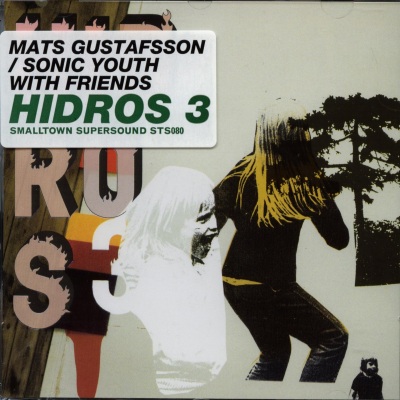
Hidros 3
Fans of Sonic Youth have come to embrace change. In between delivering prominent major-label efforts at a roughly biennial clip, the band have got their kicks in lower-profile fringe collaborations-- most notably their millennium-capping Goodbye 20th Century, which saw them interpreting the works of a host of seminal experimental composers. It's a dubious double life that draws divisive lines-- perhaps unintentionally-- between fan and fanatic, grazer and junkie. Still, it takes a strong stomach to digest some of these asides-- even for diehards. The band hit its experimental apex (or nadir) in 2000 when they released the cavorting, bohemia-smitten NYC Ghosts & Flowers. The album was met with overwhelming disapprobation and, on their subsequent major-label efforts, SY have retreated into markedly subdued territory, producing a pair of albums-- Murray Street and Sonic Nurse-- that thrive on traditional song structures. While the results of their avant-garde endeavors have not always been successful, they've all but vouchsafed Sonic Youth's legacy as a band unafraid to take risks and abruptly change direction when needed. That said, Hidros 3 (To Patti Smith) is probably not the record many of their devotees were hoping for. Instead, it's perhaps what hardened SY fans have come to expect: Something unlike anything the band have done before, and no friendlier for it. Mats Gustafsson is a well-established reed player and improviser. He's also the incidental progenitor of the fluteophone (simply a flute played with a saxophone mouthpiece). Gustafsson made his mark as a virtuoso, but the Sweden native recently chiseled himself a niche as an upstart avant-jazz composer with his diverse and often challenging Hidros series. The sequence's third installment was performed live by Sonic Youth, guitarist Loren Connors, and a slew of accompanying musicians at an October 2000 concert, and is perhaps the young composer's boldest statement to date. Stylistically, the performance harkens back to Sonic Youth's noisome early days as rogue freelancers in no-wave icon Glenn Branca's guitar-based orchestras. Hidros 3 isn't shy about its unfettered experimentalism, stridently eschewing all semblance of time and structure. The work is more of a textural tone poem-- and a rather heavy-handed one at that-- spending most of its time in a noisy netherworld of guitars, electronics, and occasional contrabass saxophone. Its rare quiet moments offer respite and a chance to collect oneself from the jarring high-volume passages, but are often marred by Kim Gordon's equally strident vocals. Gordon plays a marginal but important role, sporadically delivering anemic beat-style diatribes that serve as a comparably abrasive accompaniment to the shrill guitar fronts. It would have been nice if she were used in a more contrary fashion, perhaps as a more congenial melodic counterweight to the anarchic instrumentals a la John Cage's use of pitch-perfect opera singing against a backdrop of found sound in his Aria with Fontana Mix. But as such, Gordon ruptures the peace one might hope to find within these helter-skelter miasmas. Even without Gordon, the terrain is rough going. The first of two installments of "Processed Voice" is a 12-minute slog through marshes of caterwauling electronics and stuttering guitars. After six minutes of utter chaos, a brief and unintelligible vocal loop is incorporated, providing the movement's only source of rhythmic consistency. Elsewhere, melodic clarity is equally scarce: A fleeting solo at around the 5:30 mark of the second "Processed Voice" is as close as this collection comes to delivering a discernible hook. In Hidros 3, nothing is sacred. These rugged compositions are uniformly loud, shapeless, and often protracted to extreme lengths. There's little ambiguity about the adroitness of the guitarists' noise making, and their deft improvising takes the album in sundry directions. This transience and variety should help revive some listeners after the album's particularly dense sections. But because of Hidros' largely improvised nature, it's difficult to judge Gustafsson's composition objectively. The recording is frustratingly irresolute and demands a great deal of input from its performers. Of course, Gustafsson couldn't have done better than enlisting one of the most innovative and established guitar bands of the past 20 years. But in doing so, he vested his creative power in non-control, making for a vital document of Sonic Youth's most outre period and an adventurous, if indeterminate, mark on his own burgeoning resume.
